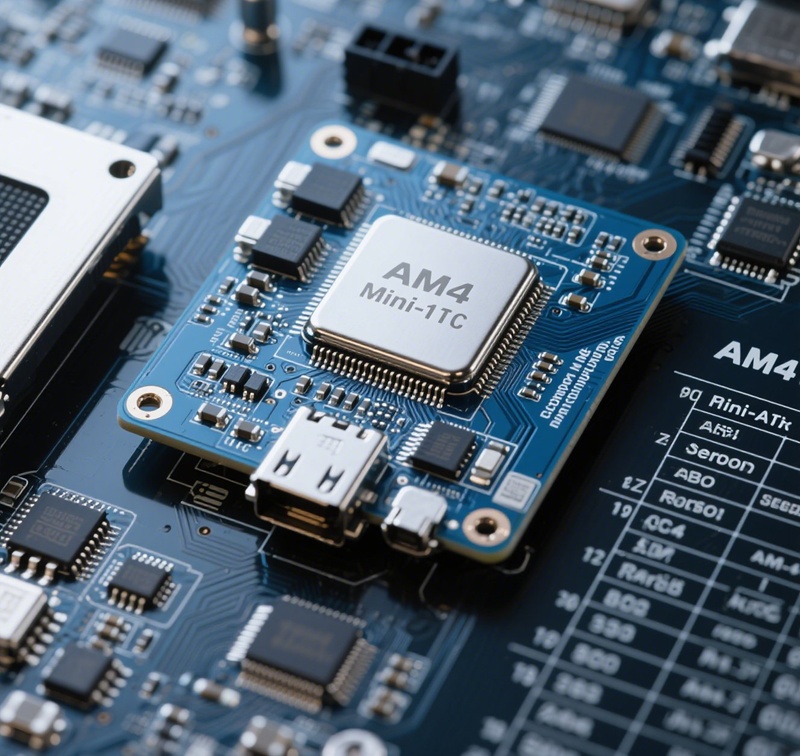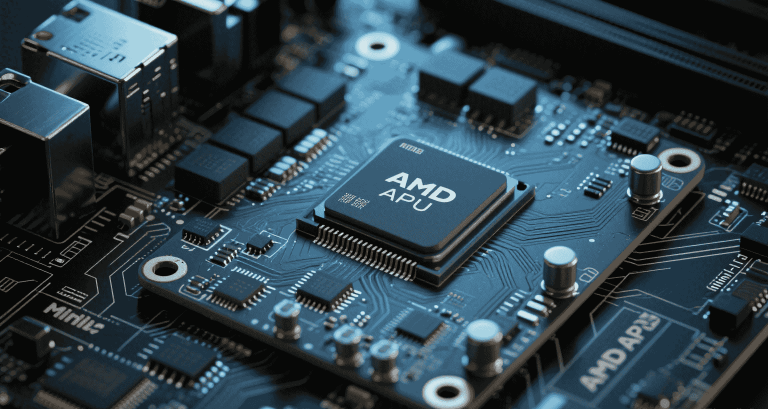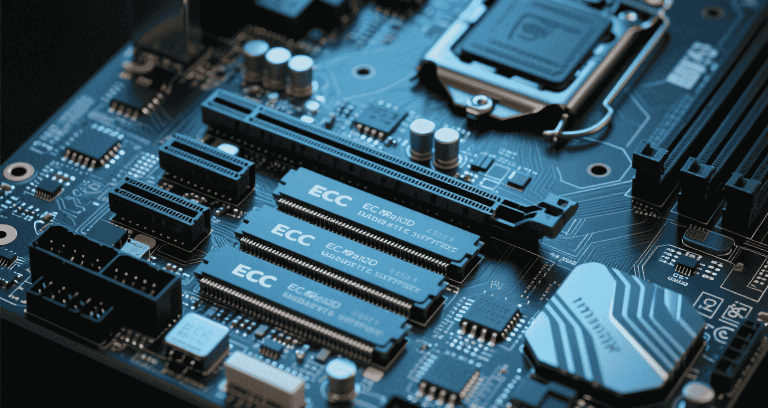AM4 Mini-ITX Motherboards for Embedded Systems and Compact PCs
Discover the best AM4 Mini-ITX motherboards for embedded systems and compact PCs. Find the perfect balance of performance and size for your project.

Table of Contents
- Introduction
- Understanding the AM4 Socket and Mini-ITX Form Factor
- Advantages of AM4 Mini-ITX Motherboards
- Limitations to Consider
- Power Delivery and VRMs
- Memory Support
- Storage Interfaces and RAID
- Expansion and Connectivity
- Thermal and Power Management
- Performance Considerations
- Selecting the Right Motherboard
- Q&A
- Conclusion
“Compact yet powerful – AM4 Mini-ITX motherboards are the backbone of modern embedded computing.”
Introduction
AM4 Mini-ITX motherboards have revolutionized how you can build high-performance systems in minimal space. I’ve deployed these boards in home theater PCs, industrial automation controllers, and portable workstations. Their combination of AMD Ryzen CPU support, modern interfaces, and compact form factor makes them ideal for many embedded and industrial computing scenarios.
In this guide, I’ll help you understand their capabilities, limitations, and selection criteria so you can make the right decision for your project.
Understanding the AM4 Socket and Mini-ITX Form Factor
The AM4 socket is AMD’s versatile platform, supporting Ryzen processors from the 1st through 5th generation. Mini-ITX boards measure only 170mm × 170mm, making them perfect for small enclosures and embedded devices.
- Compact design with no compromise on performance
- Supports up to Ryzen 9 CPUs
- Provides PCIe Gen4 lanes on B550 and X570 chipsets
These attributes have led to widespread adoption in edge computing, robotics, and compact gaming PCs.
Advantages of AM4 Mini-ITX Motherboards
There are several reasons I recommend AM4 Mini-ITX motherboards:
- Space-saving form factor that fits in 5-liter cases
- Support for high-performance CPUs and fast DDR4 memory
- Integrated Wi-Fi, Bluetooth, and 2.5G Ethernet
- Reduced power consumption compared to larger boards
| Feature | Benefit |
|---|---|
| Compact Size | Ideal for embedded and portable applications |
| Modern I/O | Multiple USB 3.2 ports, HDMI/DisplayPort, M.2 |
| Energy Efficiency | Lower idle and peak power draw |
These benefits make AM4 Mini-ITX an excellent choice for many use cases.
Limitations to Consider
While AM4 Mini-ITX boards are powerful, you should be aware of these limitations:
- Limited expansion slots – typically only one PCIe x16 slot
- Maximum of two DIMM slots (up to 64GB RAM)
- Tighter thermal constraints under sustained load
“Plan your build carefully. Space constraints can quickly turn into thermal bottlenecks,” – MiniITXboard Specialist
Power Delivery and VRMs
Power delivery is critical for system stability, especially if you plan to run Ryzen 7 or Ryzen 9 CPUs. You’ll see boards with 6+2 or 8+2 phase VRM designs and substantial heatsinks. Look for robust VRMs and cooling solutions if you intend to overclock.
4+2 phases – Entry level Ryzen 3
6+2 phases – Ryzen 5/7
8+2 phases – Ryzen 9, Overclocking
Memory Support
All AM4 Mini-ITX boards use DDR4 dual-channel memory. While two slots limit capacity, you can still reach 64GB with modern 32GB DIMMs.
| Memory Speed | Supported CPUs |
|---|---|
| Up to 3200MHz | Ryzen 1000/2000 Series |
| Up to 3600MHz+ | Ryzen 3000 Series |
| Up to 5100MHz (OC) | Ryzen 5000 Series |
I recommend you consult your board’s QVL list to ensure compatibility with high-frequency kits.
Storage Interfaces and RAID
AM4 Mini-ITX boards provide both SATA and M.2 storage options.
- Up to 4 SATA III ports for SSDs or HDDs
- 1–2 M.2 slots supporting PCIe Gen3/Gen4 NVMe drives
- RAID 0, 1, and 10 support (check specific models)
| Interface | Speed | Use Case |
|---|---|---|
| SATA III | 6Gbps | Mass storage |
| M.2 NVMe | 32–64Gbps | OS boot drive |
Expansion and Connectivity
Even in compact builds, you get a wealth of connectivity options:
- 1 PCIe x16 slot for GPU or accelerator card
- Multiple USB 3.2 Gen2 ports
- 2.5Gb Ethernet and onboard Wi-Fi 6
- HDMI and DisplayPort video outputs
This combination makes it suitable for everything from media servers to small business workstations.
Thermal and Power Management
Thermal design is essential. I recommend:
- Top-down CPU coolers to direct airflow across VRMs
- SFX power supplies to reduce internal heat
- Case fans with positive pressure to improve cooling
Proper planning will prevent throttling under load.
Performance Considerations
With the right components, AM4 Mini-ITX can rival full ATX builds. The key is to avoid thermal and power bottlenecks. Use efficient power supplies and consider under-volting high-TDP CPUs if you cannot provide adequate cooling.
Selecting the Right Motherboard
When choosing an AM4 Mini-ITX board, I recommend considering:
- VRM phase count and heatsink design
- Number of M.2 and SATA ports
- PCIe Gen4 support if you need maximum NVMe performance
- Onboard Wi-Fi and Bluetooth
Brands like ASUS, Gigabyte, and ASRock have reliable models. For industrial-grade options, explore MiniITXboard.
Q&A
Q1: Are AM4 Mini-ITX motherboards suitable for gaming PCs?
A: Yes, AM4 Mini-ITX motherboards can absolutely be used for gaming. They support powerful Ryzen CPUs and full-sized GPUs via the PCIe x16 slot. However, you must pay extra attention to cooling and case airflow because the compact size limits the space available for large air coolers. I recommend using efficient SFX power supplies and a well-ventilated Mini-ITX case if you plan to build a gaming system.
Q2: What CPU is best for low power consumption and quiet operation?
A: For energy-efficient builds, the Ryzen 5 5600G is a great option because it has a modest TDP (65W) and includes integrated Radeon graphics. This means you can skip a discrete GPU, which further reduces power draw and heat. It’s an excellent choice for compact workstations, HTPCs, and embedded systems where quiet operation is a priority.
Q3: Can I configure RAID arrays on an AM4 Mini-ITX motherboard?
A: Yes, most AM4 Mini-ITX motherboards with B550 or X570 chipsets support RAID 0, 1, and 10 configurations across SATA drives. Some also allow RAID with M.2 NVMe drives, but check the manual carefully, as not all boards permit mixing RAID sets between SATA and NVMe. You’ll configure RAID in the UEFI BIOS interface before installing the operating system.
Q4: What cooling solutions are recommended for Mini-ITX builds?
A: Because airflow is limited in small enclosures, I recommend low-profile air coolers like the Noctua NH-L9a or compact AIO liquid coolers such as the Corsair H60. Ensure your case has at least one intake and one exhaust fan to maintain steady airflow. If you’re using higher-TDP CPUs, invest in a case with mesh panels and space for 120mm or 140mm fans.
Q5: Is PCIe Gen4 storage support necessary for most use cases?
A: PCIe Gen4 NVMe drives offer very high sequential speeds (up to 7000 MB/s), which benefits workloads like video editing, 3D rendering, and scientific computing. For typical office or gaming use, PCIe Gen3 SSDs are still fast enough. However, if you’re investing in a new system, choosing a board with PCIe Gen4 capability provides better future-proofing.
Q6: Where can I purchase high-quality AM4 Mini-ITX motherboards with reliable support?
A: You can find excellent AM4 Mini-ITX motherboards at specialist suppliers such as MiniITXboard. They stock industrial-grade boards with extended lifecycle support and offer technical guidance on selecting components, thermal design, and deployment strategies for embedded applications. For enterprise or critical workloads, sourcing from a trusted vendor ensures better warranty coverage and professional assistance if issues arise.
Conclusion
AM4 Mini-ITX motherboards combine compact design with impressive performance. With careful planning of power, cooling, and expansion, you can build a system rivaling much larger platforms. For professional and industrial-grade options, explore the selection at MiniITXboard.


